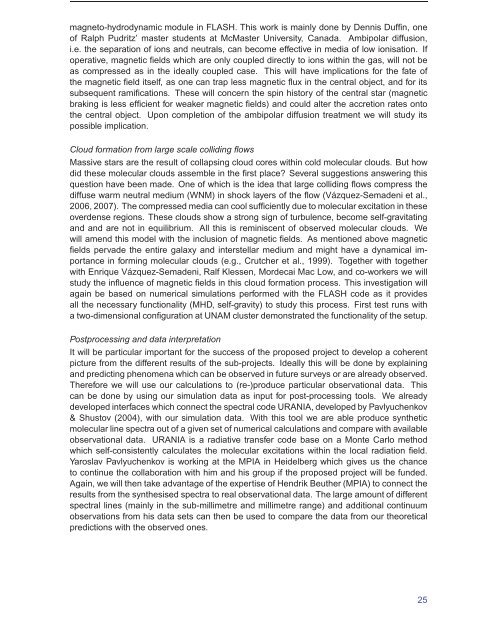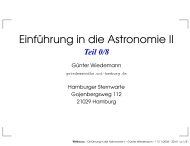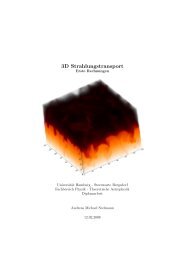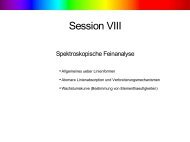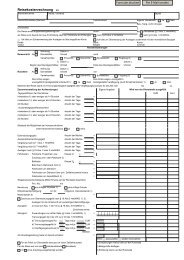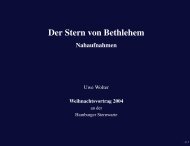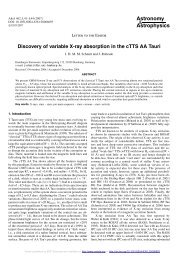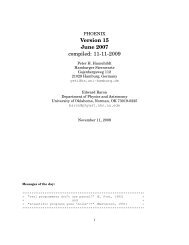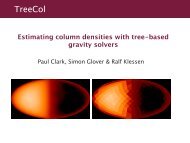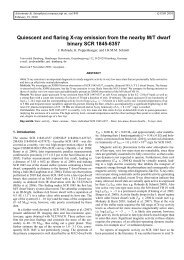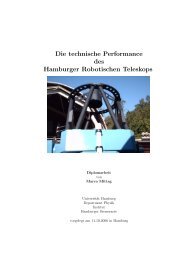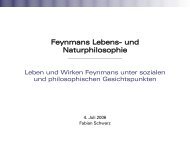Emmy Noether Application
Emmy Noether Application
Emmy Noether Application
You also want an ePaper? Increase the reach of your titles
YUMPU automatically turns print PDFs into web optimized ePapers that Google loves.
magneto-hydrodynamic module in FLASH. This work is mainly done by Dennis Duffin, one<br />
of Ralph Pudritz’ master students at McMaster University, Canada. Ambipolar diffusion,<br />
i.e. the separation of ions and neutrals, can become effective in media of low ionisation. If<br />
operative, magnetic fields which are only coupled directly to ions within the gas, will not be<br />
as compressed as in the ideally coupled case. This will have implications for the fate of<br />
the magnetic field itself, as one can trap less magnetic flux in the central object, and for its<br />
subsequent ramifications. These will concern the spin history of the central star (magnetic<br />
braking is less efficient for weaker magnetic fields) and could alter the accretion rates onto<br />
the central object. Upon completion of the ambipolar diffusion treatment we will study its<br />
possible implication.<br />
Cloud formation from large scale colliding flows<br />
Massive stars are the result of collapsing cloud cores within cold molecular clouds. But how<br />
did these molecular clouds assemble in the first place? Several suggestions answering this<br />
question have been made. One of which is the idea that large colliding flows compress the<br />
diffuse warm neutral medium (WNM) in shock layers of the flow (Vázquez-Semadeni et al.,<br />
2006, 2007). The compressed media can cool sufficiently due to molecular excitation in these<br />
overdense regions. These clouds show a strong sign of turbulence, become self-gravitating<br />
and and are not in equilibrium. All this is reminiscent of observed molecular clouds. We<br />
will amend this model with the inclusion of magnetic fields. As mentioned above magnetic<br />
fields pervade the entire galaxy and interstellar medium and might have a dynamical importance<br />
in forming molecular clouds (e.g., Crutcher et al., 1999). Together with together<br />
with Enrique Vázquez-Semadeni, Ralf Klessen, Mordecai Mac Low, and co-workers we will<br />
study the influence of magnetic fields in this cloud formation process. This investigation will<br />
again be based on numerical simulations performed with the FLASH code as it provides<br />
all the necessary functionality (MHD, self-gravity) to study this process. First test runs with<br />
a two-dimensional configuration at UNAM cluster demonstrated the functionality of the setup.<br />
Postprocessing and data interpretation<br />
It will be particular important for the success of the proposed project to develop a coherent<br />
picture from the different results of the sub-projects. Ideally this will be done by explaining<br />
and predicting phenomena which can be observed in future surveys or are already observed.<br />
Therefore we will use our calculations to (re-)produce particular observational data. This<br />
can be done by using our simulation data as input for post-processing tools. We already<br />
developed interfaces which connect the spectral code URANIA, developed by Pavlyuchenkov<br />
& Shustov (2004), with our simulation data. With this tool we are able produce synthetic<br />
molecular line spectra out of a given set of numerical calculations and compare with available<br />
observational data. URANIA is a radiative transfer code base on a Monte Carlo method<br />
which self-consistently calculates the molecular excitations within the local radiation field.<br />
Yaroslav Pavlyuchenkov is working at the MPIA in Heidelberg which gives us the chance<br />
to continue the collaboration with him and his group if the proposed project will be funded.<br />
Again, we will then take advantage of the expertise of Hendrik Beuther (MPIA) to connect the<br />
results from the synthesised spectra to real observational data. The large amount of different<br />
spectral lines (mainly in the sub-millimetre and millimetre range) and additional continuum<br />
observations from his data sets can then be used to compare the data from our theoretical<br />
predictions with the observed ones.<br />
25


